Ditching 90% of your stuff starts with assessing what you own. Evaluate each item based on usage and emotional value. Set clear goals, like a timeline for decluttering, and break tasks into manageable steps. Consider donating or selling items you no longer need. Embrace a minimalist lifestyle to enjoy richer experiences and reduced stress. You'll discover freedom in simplicity and a deeper appreciation for what truly matters. Discover how to maintain this fulfilling lifestyle moving forward.
Key Takeaways
- Create a detailed inventory of your belongings to identify what you truly need and value.
- Establish a decision framework to evaluate items based on usage and emotional significance.
- Set SMART goals and break decluttering into smaller, manageable tasks to maintain motivation.
- Focus on intentional purchasing by reflecting on your values and prioritizing quality over quantity.
- Embrace donating or upcycling items to support sustainability and reduce clutter in your life.
Understanding Minimalism and Its Benefits
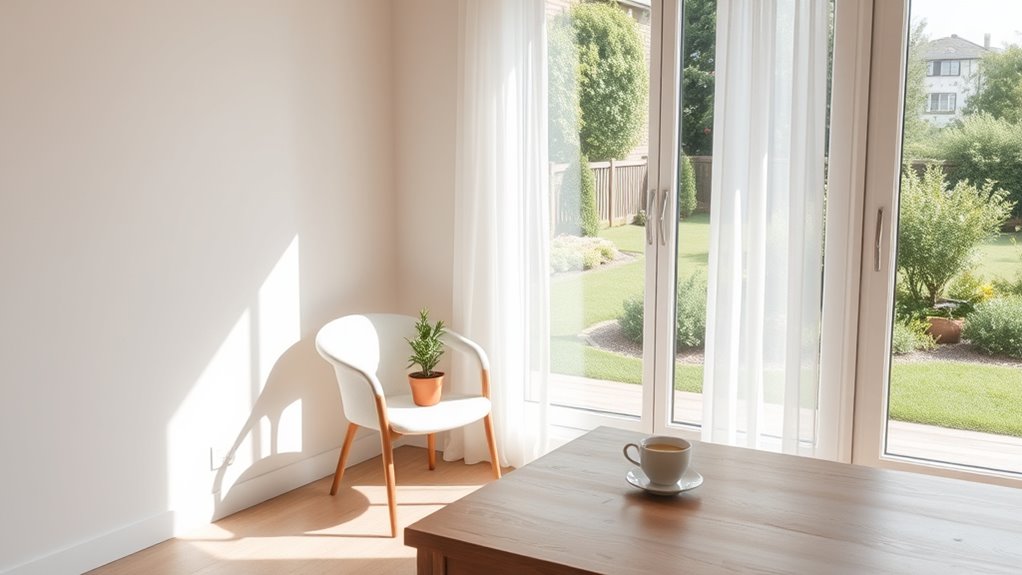
When you embrace minimalism, you're choosing a lifestyle that prioritizes simplicity and intentionality, allowing you to focus on what truly matters. This approach encourages you to reduce clutter and shift your attention from possessions to experiences, which can enhance your well-being.
You might find that minimalism reduces stress, boosts productivity, and fosters mental clarity by eliminating distractions. By living more mindfully, you're likely to develop deeper connections with others and engage more meaningfully in your community.
Additionally, adopting minimalism often aligns with sustainability, reducing waste and promoting environmental responsibility. Ultimately, minimalism not only transforms your space but also enriches your life, encouraging personal growth and a healthier mindset. Embracing sustainable habits can further enhance your overall well-being.
Assessing Your Current Belongings

As you begin the journey to declutter, assessing your current belongings is a crucial first step.
Start by creating a comprehensive inventory of everything you own to understand the sheer volume of items. Evaluate each item based on its usage and sentimental value, which will help you make informed decisions. Consider the space each item occupies; this can highlight what's essential versus what's merely taking up room. Effective wall organization can enhance your living space by promoting order and reducing clutter. Acknowledge any emotional attachments you have, as they can complicate your choices. Establishing a clear decision framework simplifies the process of what to keep or discard. By taking these steps, you'll lay a solid foundation for a more intentional living space, making the decluttering journey much more manageable. Additionally, decluttering before a move can significantly reduce the number of items to pack and lessen the emotional burden associated with the transition.
Setting Clear Goals for Decluttering
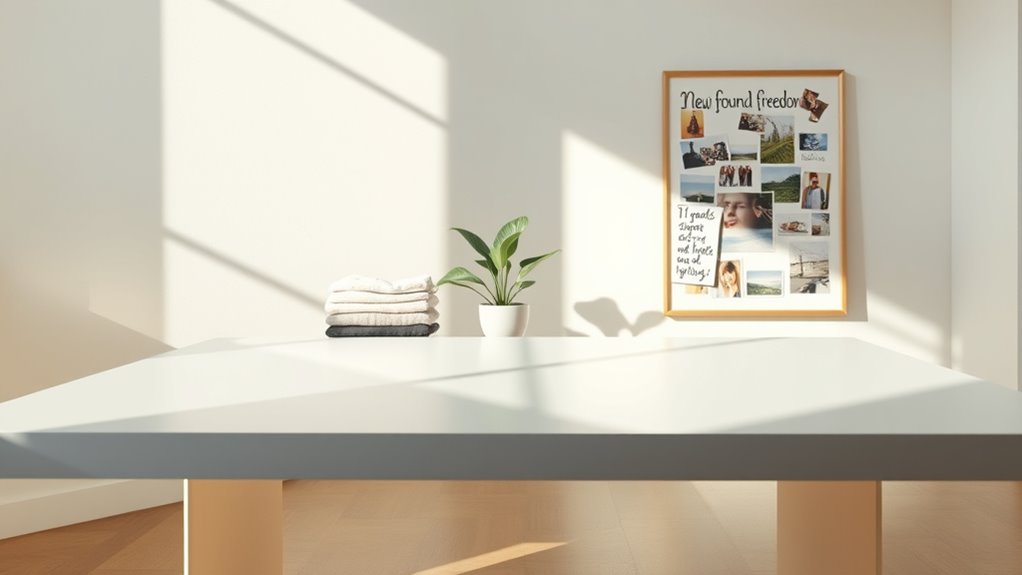
Setting clear goals for decluttering can significantly streamline your efforts and keep you motivated throughout the process.
Start by reflecting on your motivation—understanding why you want to declutter helps maintain focus. Break down larger tasks into smaller steps to avoid feeling overwhelmed, and use SMART criteria to ensure your goals are Specific, Measurable, Achievable, Relevant, and Time-bound. Additionally, creating a decluttering schedule can help you maintain consistency and make progress over time. Implementing designated zones for specific activities or items can further enhance your organization.
Prioritize areas that need the most attention, and set realistic expectations based on your available time and energy. Write down your goals to make them tangible, and assign deadlines to keep you on track.
The 30-Day Decluttering Challenge
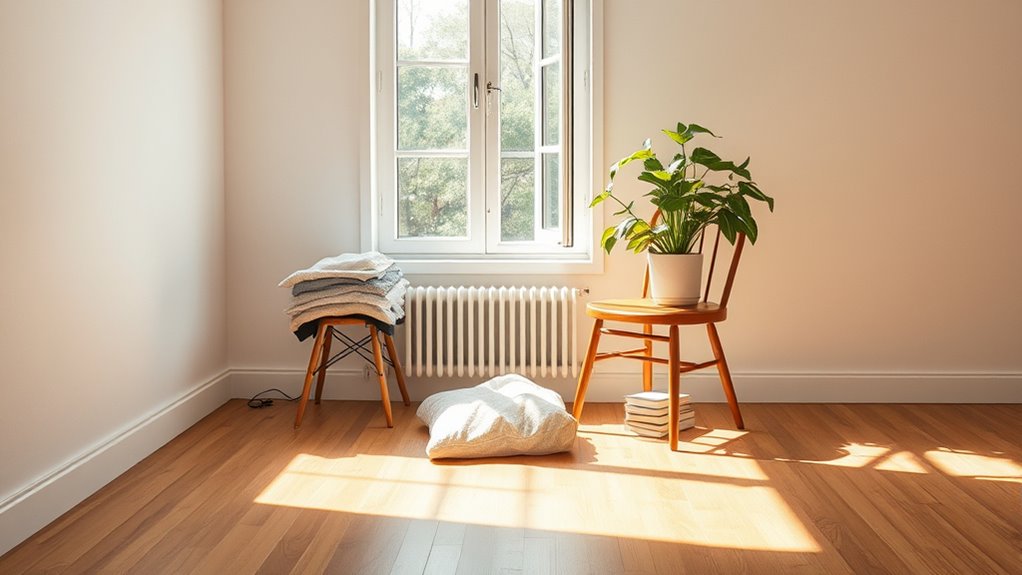
The 30-Day Decluttering Challenge is an effective way to transform your space and simplify your life, one day at a time. Each day, focus on a specific area of your home, like your closet or kitchen counter. Set a timer for 15-30 minutes to stay focused and efficient. To track your progress, use a printable calendar or tracker, marking off completed tasks as you go. Establish a donation station to organize items you're ready to part with, and gather cleaning supplies for quick tidy-ups. For added motivation, consider daily videos or social media updates. Regular decluttering helps prevent overwhelm from accumulated clutter, making this challenge even more impactful. Additionally, creating an organized space can significantly enhance the quality of life for seniors, making daily tasks easier and more enjoyable.
Identifying Items to Let Go
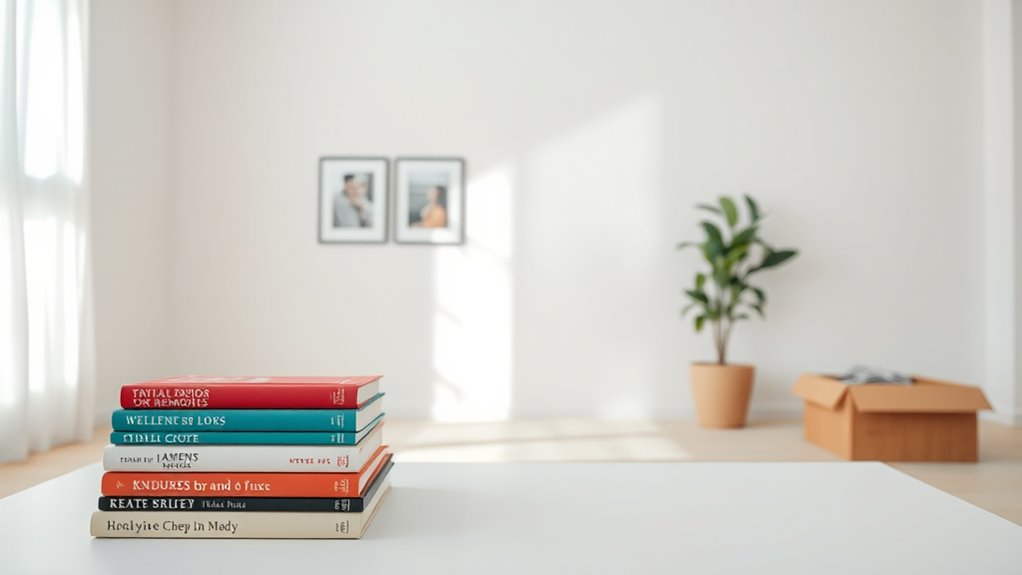
How do you decide what to let go when decluttering your space? Start by identifying items that have outlived their usefulness. Discard dead batteries, expired medications, and broken items that can't be recovered.
Clear out duplicate kitchen utensils and old electronics—consider recycling or donating them. Check your closet for clothing and textiles you no longer wear or need. Don't forget those junk drawers; they often hide unnecessary clutter. Decluttering involves removing unnecessary items to enhance the functionality of your space and create a sense of calm in your environment.
When dealing with sentimental items, assess whether they still serve a purpose in your life. Keep only meaningful photos or family heirlooms that bring joy.
Finally, sort through bathroom products, tools, and cleaning supplies, keeping just what you use regularly. This process will help you create a more functional space.
The Art of Intentional Purchasing
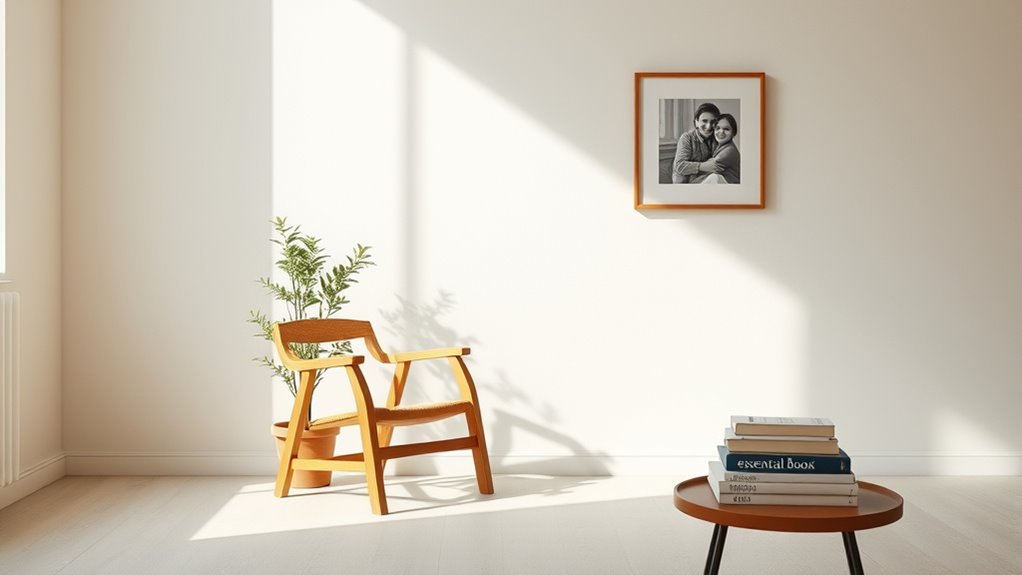
After clearing out unwanted items from your space, it's time to focus on what goes in. Intentional purchasing is all about making mindful choices that align with your values.
Every item you buy has environmental impacts, so consider durability and recyclability to reduce your carbon footprint. Prioritize quality over quantity—fewer, high-quality items lead to greater satisfaction and long-term fulfillment. Every purchase has an environmental cost associated with production and shipping, which makes it crucial to choose wisely. Additionally, consider the importance of planning for future needs, including how your purchases may affect your financial situation.
Reflect before buying to avoid impulse purchases, ensuring your spending aligns with your personal goals. Support ethical practices by choosing fair trade and local products, which contribute to a more equitable economy.
Creating a Capsule Wardrobe

Embrace simplicity by creating a capsule wardrobe that streamlines your clothing choices and reflects your personal style.
Start by auditing your current wardrobe, separating pieces you love from those you don't wear. Set clear goals for what you want your capsule to achieve, then categorize your clothing into tops, bottoms, and dresses.
Choose versatile pieces that mix and match easily, aiming for around 33 items total. Include essential clothing, seasonal updates, and a few accessories and shoes that complement various outfits. This process not only simplifies your choices but also promotes a minimalist lifestyle that aligns with your values.
Keep in mind your lifestyle, considering work requirements, weather, and special events. Regularly review and adjust your wardrobe, focusing on quality over quantity, and make mindful purchases to maintain a fresh, functional collection.
Selling vs. Donating Unused Items

Wondering whether to sell or donate your unused items? Selling can recapture some of their original value, providing you with immediate financial benefits. Plus, it helps ensure your items end up with someone who truly values them. However, selling requires more effort—think listing, negotiating, and shipping. On the other hand, donating is generally easier and supports charities while keeping items out of landfills. Just remember to donate only items in good condition. In fact, Goodwill's donations help reduce textile waste significantly while providing low-cost options for those in need. You might gain tax benefits, too. Additionally, regular screenings for breast cancer can be vital in promoting awareness and early detection of this serious illness. Weigh your options: if an item has market demand, consider selling; if not, donating could be the way to go. Ultimately, choose the method that aligns with your values and goals.
Maintaining a Minimalist Lifestyle
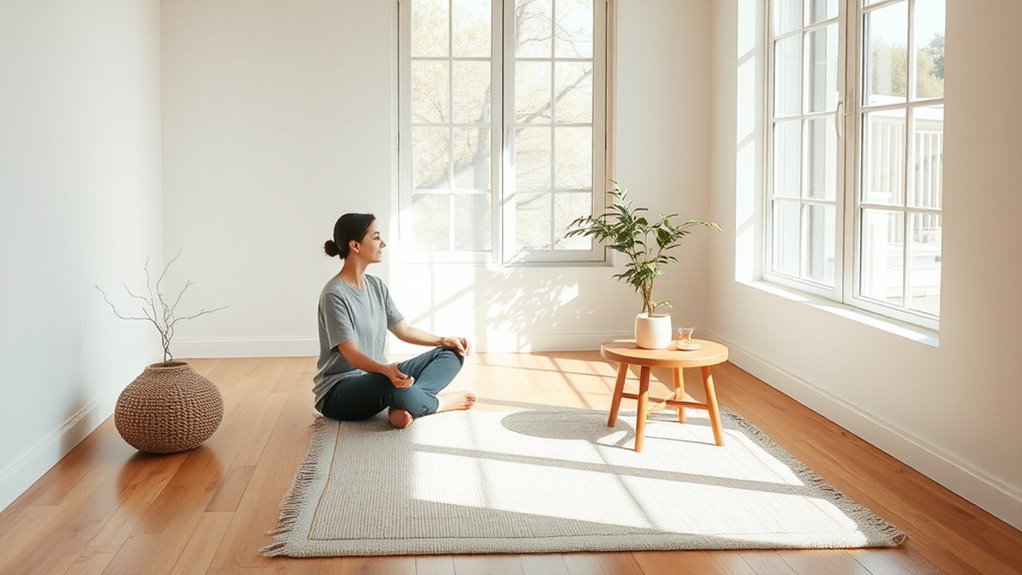
Deciding whether to sell or donate your unused items is just the first step in your journey toward a minimalist lifestyle.
To maintain this lifestyle, tackle decluttering gradually; focus on small tasks so you don't feel overwhelmed. Keep your motivation strong by reflecting on why you chose minimalism. Simplified environments can significantly enhance your productivity and focus, making it easier to complete daily tasks efficiently. Embracing halal lifestyles can also inspire you to prioritize meaningful and purposeful possessions.
Get creative with upcycling before discarding items, and consider seasonal storage for things you only need occasionally.
Make decluttering a daily habit—just a few minutes a day can keep your space clear.
Prioritize quality over quantity when acquiring new items, and always think about their environmental impact.
This approach not only reduces stress and increases productivity but also aligns with your values, enhancing your overall well-being.
Embracing the Freedom of Less

Many people find that embracing the freedom of less can transform their lives in unexpected ways. By shedding unnecessary possessions, you liberate yourself from clutter and distractions, allowing for a clearer focus on what truly matters. The 90+ Minimalist Rule helps you evaluate each item based on its value, ensuring you keep only what enhances your life. As you declutter, you'll likely experience reduced stress and improved well-being, fostering a mindset that prioritizes experiences over things. This shift not only saves you money but also positively impacts the environment, as embracing the freedom of degrees of freedom leads to a more intentional lifestyle. As minimalist lifestyles gain popularity, you'll discover that living intentionally brings a fulfilling sense of freedom, making room for joy and simplicity in your life.
Frequently Asked Questions
How Do I Handle Sentimental Items While Decluttering?
Handling sentimental items while decluttering can be tough. Start by acknowledging your emotional attachments and setting clear boundaries on what to keep.
Share stories connected to these items to help release some of that emotional weight. Document memories through photos or writing, and focus on what truly brings you joy.
Consider creating a memory box for the most cherished pieces, and remember, it's okay to let go of things that no longer serve you.
What if I Regret Getting Rid of Something?
Imagine standing in a gallery of your life, each item a brushstroke in your story.
If you regret getting rid of something, take a moment to reflect. You can always document it—snap a photo or jot down your memories.
If it was truly meaningful, consider storing it temporarily.
Remember, decluttering isn't about loss; it's about clarity.
Embrace the space you've created, and trust that your journey will unfold beautifully.
Can Minimalism Work for Families With Children?
Absolutely, minimalism can work for families with children!
You'll find that reducing clutter lowers stress and boosts creativity for everyone. By involving your kids in the decluttering process, you teach them valuable life skills while fostering a sense of responsibility.
As you simplify your home, you'll likely enjoy more quality family time and save money. Embracing minimalism can create a harmonious environment that supports both your family's well-being and togetherness.
How Do I Convince Others to Embrace Minimalism?
To convince others to embrace minimalism, start by sharing your personal experiences and the benefits you've gained.
Use humor to make the concept approachable, and highlight success stories of others who've thrived.
Collaborate on decluttering projects, turning it into a fun challenge.
Focus on the positive impacts, like saved time and money, and celebrate small victories together.
Avoid preaching; instead, inspire through action and demonstrate how minimalism can enhance life.
What Are the Best Apps for Tracking My Minimalism Journey?
When you're tracking your minimalism journey, several apps can help.
Loop offers a simple interface for habit tracking, while HabitBull provides detailed analytics and customizable reminders.
Everyday helps you maintain streaks across platforms, and Habitify allows you to group habits for better tracking.
If you want reminders and customization, Goalify's a great choice.
Each app can enhance your awareness and motivation as you simplify your life. Choose what resonates with you!
Conclusion
By letting go of 90% of your stuff, you're not just clearing space; you're creating room for what truly matters. Imagine a life unburdened by excess, where each item sparks joy rather than chaos. As you embrace minimalism, you'll discover that freedom lies in simplicity. So, take the plunge—your future self, unencumbered and thriving, will thank you for it. After all, isn't it time to prioritize experiences over possessions?









